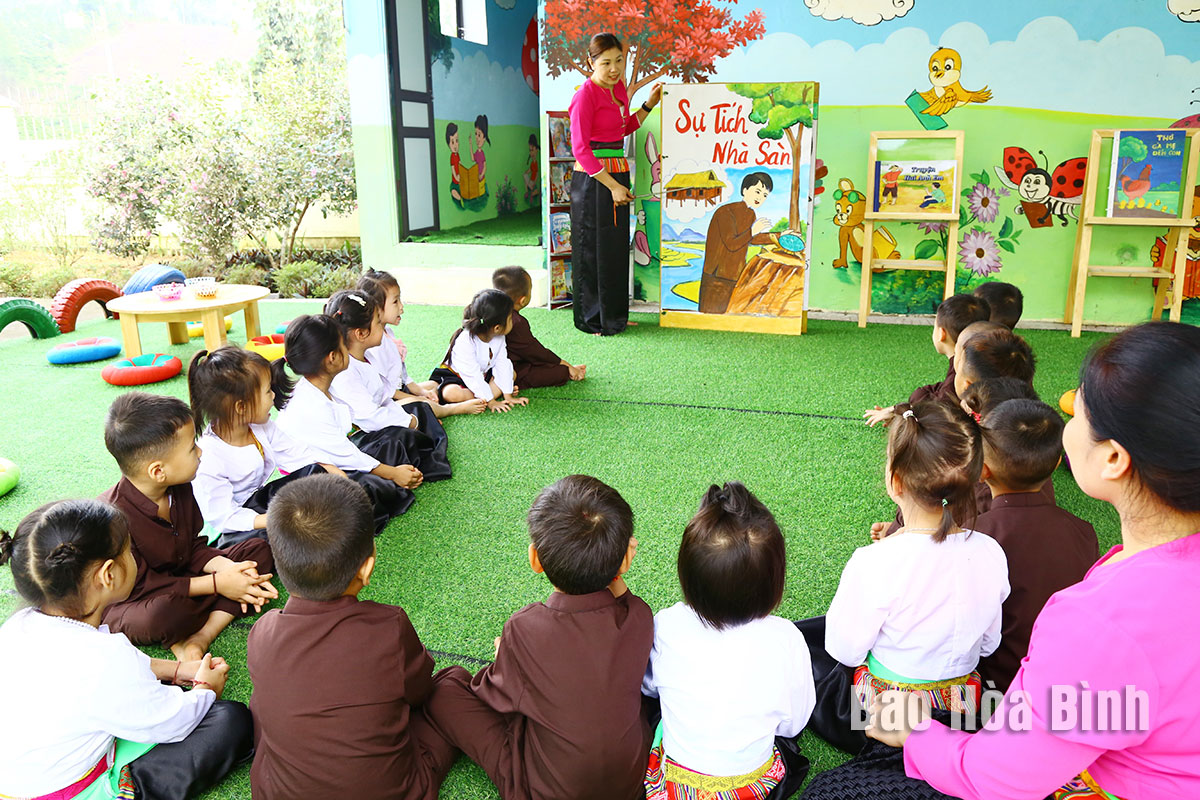
Over the past years, the northern mountainous province of Hoa Binh has kept fostering the holistic development of its citizens, with priority to moral virtue, brainpower, physical fitness, and aesthetics.
Lac Sy commune preschool in Yen Thuy district pays attention to integrating
cultural preservation into educational environment
Educating traditional values for young generation
Attention has been paid to all-round education from early school years. In the
remote Lac Sy commune of Yen Thuy district, Lac Sy preschool has successfully
launched a model on building an educational environment linked with local cultural
preservation. Walking through the school campus, visitors can explore a
traditional cultural corner featuring a stilt house and everyday items of the
Muong people, including looms, traditional attire, and culinary artifacts.
Teachers have curated educational content using large storybooks of folklore,
such as The Legend of the Stilt House, Ong Dung Ba Doang, and De Dat De Nuoc,
which enrich the learning experience for young children. Moreover, play areas
filled with traditional Muong games like bamboo dancing and stilt walking
encourage physical activity while connecting children with their cultural
roots. Every Monday and during festivals, students dress in Muong traditional
attire, with the school achieving 100% participation.
Nguyen
Quang Minh, Deputy Director of the provincial Department of Education and
Training, said these initiatives align with Hoa Binh’s goal of bringing local
history and culture closer to the youth. The local education sector has been
following national guidelines to integrate local cultural education
effectively.
Building a vibrant cultural environment
Alongside
nurturing individuals, Hoa Binh also focuses on creating a vibrant cultural
environment, a responsibility embraced by local authorities as a long-term
mission.
In 2023,
around 88.3% of households were recognised as "Cultural Families,"
and nearly all villages and communities reached the "Cultural
Community" standard. Additionally, about 92.8% of agencies and businesses
met cultural standards. These statistics reflect the commitment to upholding
Hoa Binh's cherished values of love, community spirit, and shared
responsibility for local development.
The
province celebrates key events such as International Day of Happiness (March
20), Vietnamese Family Day (June 28), and the National Action Month for Gender
Equality. Furthermore, regular workshops on family ethics, sustainable family
development clubs, and initiatives against domestic violence help reinforce
community bonds and foster positive values across generations./.
Phong Phu commune, Tan Lac district of Hoa Binh province, is widely regarded as the cultural heartland of the Muong ethnic group. Among its many traditional communities, Luy Ai hamlet (formerly Ai hamlet) stands out as a rare location where the customs and way of life of the Muong Bi people remain largely intact.
The Truong Kha temple festival, a distinctive cultural event held every three years in Vu Ban township, Lac Son district, returned recently with vibrant rituals and folk traditions of the Muong people. Located next to the Buoi River in the Muong Trao fields, the Truong Kha Temple is dedicated to the three Kun Dol deities, revered for teaching farming techniques, irrigation, weaving, and protecting the harvest.
The demand for spaces serving community activities of residents in various areas across Hoa Binh city has been satisfied as local cultural houses now feature modern, spacious facilities thanks to the effective implementation of Resolution No. 49/NQ-HDND issued on December 28, 2021 by the city People's Council, which approved the plan for reorganising, converting, and allocating land for the construction, repair, and expansion of cultural houses in Hoa Binh’s villages and residential areas until 2025.
At the end of May, the Hoa Binh Provincial Ethnic Arts Troupe organized a series of performances for residents in Region 2 and Region 3 communes across the province. Bringing art to ethnic communities in remote, isolated, and especially disadvantaged areas has become a meaningful activity. These are not merely artistic performances but also journeys to disseminate cultural values, enrich spiritual life, and contribute to preserving the cultural identity of ethnic minorities.



